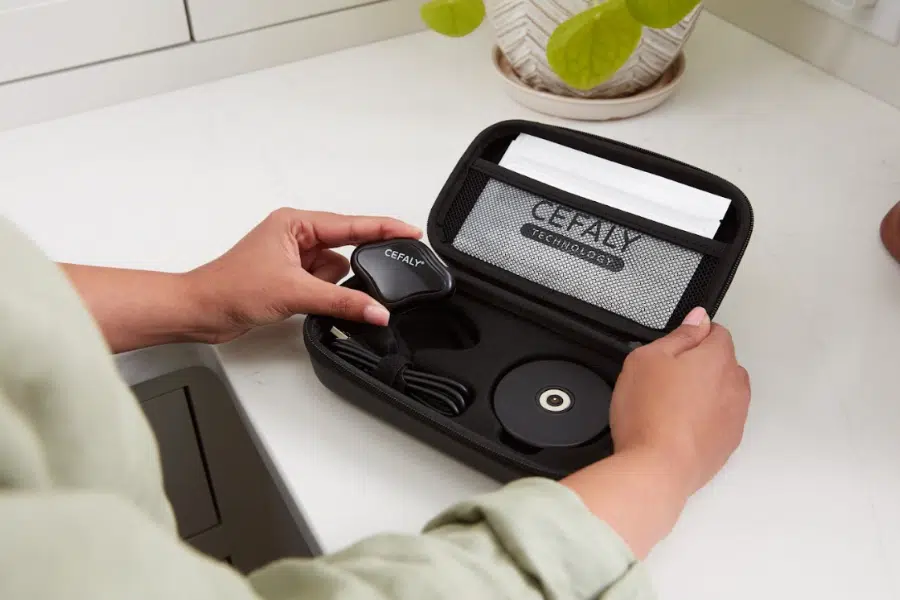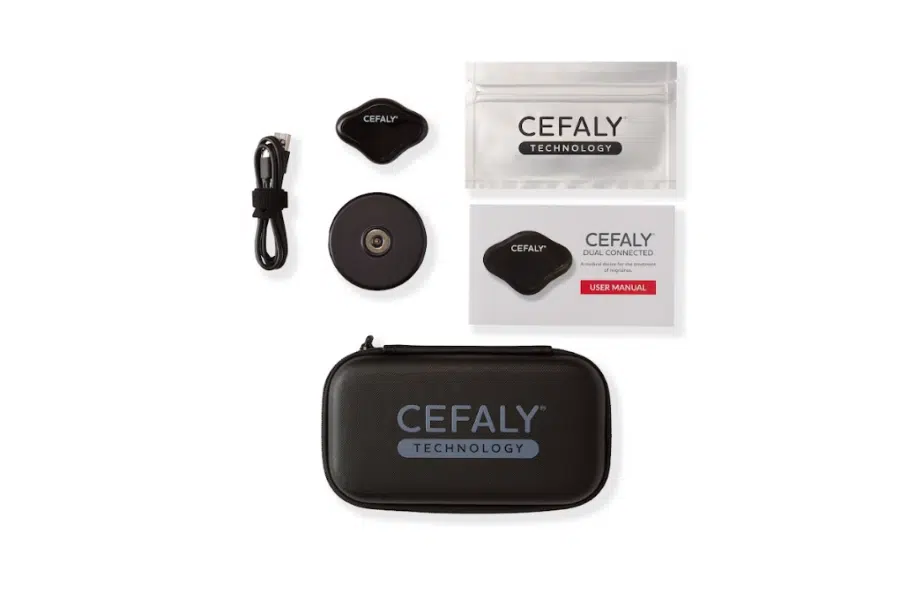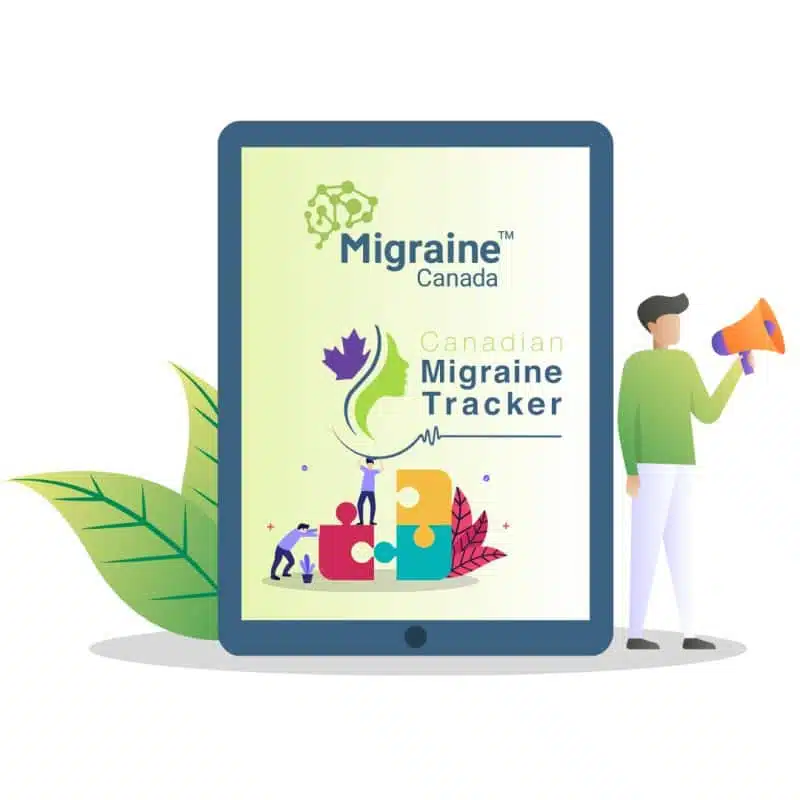Discover how the CEFALY device offers relief from migraine through transcutaneous stimulation. Approved for both acute and preventative treatment of migraine, CEFALY targets the trigeminal nerve to modulate pain processing. Explore its advantages, research findings, and potential for managing migraine effectively in this post.
What is the CEFALY device?
CEFALY is a non-invasive, drug-free wearable device to help relieve migraine pain and decrease migraine days.
The first version of CEFALY resembled a tiara, while the newest version attaches directly to the forehead via an adhesive electrode and has Bluetooth capability to pair with the CeCe Migraine Management app.
What are the advantages of CEFALY?
- Not only does CEFALY offer a drug-free approach to migraine, but it can also be used alongside medication and other approaches in a patient’s migraine toolkit.
- CEFALY does not require ongoing subscription fees and is yours to keep.
- CEFALY offers a 90-day risk-free trial, to give patients time to ensure they’re satisfied with their results.
- Unlike other migraine devices, CEFALY does not require a prescription.

How does CEFALY work?
CEFALY is an external trigeminal nerve stimulation (eTNS) device. The trigeminal nerve—an important nerve involved in migraine pain—is located under the skin of your forehead. The CEFALY device is designed to stimulate the nerve endings of this branch via an electrode placed on the forehead between the eyebrows. Once the electrode is in place, the device magnetically attaches to it and sends small electrical impulses to desensitize the nerve.

Is there research evidence that CEFALY works?
Yes. There have been three major studies on the safety and efficacy of CEFALY. The PREMICE Study evaluated CEFALY for safety and efficacy for preventative use. The ACME and TEAM studies evaluated CEFALY for safety and efficacy for acute use at both 1 and 2 hours respectively.
Who participated in the studies?
The PREMICE study involved 67 participants who experienced episodic migraine a minimum of 2 days per month. There were no patients with chronic migraine or taking medication for preventative treatment in the previous 3 months.
The ACME study involved 106 participants experiencing a migraine attack with or without aura lasting at least 3 hours. Pain severity had to be stable for at least an hour prior to enrollment with no medication 3 hours prior to enrollment.
The TEAMS study involved 538 participants. Participants had a diagnosis of episodic migraine with or without aura for at least 1 year, a migraine diagnosis before age 50, and 2-8 monthly migraine frequency with moderate to severe intensity.
How did the participants use CEFALY?
THe PREMICE study protocol was 20 minutes per day for 3 months. There was a placebo group that received a CEFALY with weaker electrical stimulation.
The ACME study protocol was a one hour session administered at the study site.
The TEAM study protocol was to initiate an Acute session within 4 hours of migraine onset. This was a 2 hour treatment time with 2 Acute sessions back to back.

What were the results?
In the PREMICE study, 38.1% of CEFALY users saw at least a 50% reduction in the number of migraine days. Among these responders, there was a 75% reduction in acute antimigraine medications.
In the ACME study, 79% of the participants saw pain relief and 32% saw complete pain freedom.
In the TEAM study, participants saw a 56.4% reduction in their most bothersome symptom, 42% of participants saw resolution of all migraine associated symptoms, and 25% saw complete pain freedom.
Are there any side effects?
No adverse events were reported.
CEFALY has few side effects, which have been demonstrated through clinical trials to be minor and fully reversible with cessation of device use.
Common
Sleepiness – Sleepiness is a common side effect after CEFALY treatments. This means that CEFALY cannot be used when driving, operating machinery, or during any activity that can put you at risk of injury. Approximately 0.5% of subjects reported sleepiness during the session.
Headache After a Session – Approximately 0.5% of subjects reported a headache after a session of preventative treatment (Program 2 – PREVENT Treatment).
Uncommon
Forehead Skin Redness – At the end of the session, the skin on the forehead under the electrode may occasionally appear blotchy due to increased local blood flow. This redness may persist for several minutes and usually disappears within 15 minutes. Approximately 0.2% of subjects reported reversible forehead skin redness.
Nausea – A rare occurrence of nausea during a session of acute treatment (Program 1 – ACUTE Treatment) has been reported.
Rare
Forehead Skin Allergy – In rare cases, an allergy to the electrode gel can occur, leading to a temporary rash on the forehead. If this happens, stop using CEFALY and contact your doctor or the manufacturer. The rash will gradually disappear within a few days. An anti-inflammatory cream may help speed up the process. Fewer than 1 in 1000 subjects reported an allergic skin reaction.
Glossary:
CEFALY is an FDA-cleared, over-the-counter wearable medical device that’s clinically proven to relieve migraine pain and reduce migraine frequency. The CEFALY device provides drug-free migraine relief without a prescription and with minimal side effects.
CEFALY uses external trigeminal nerve stimulation (eTNS) to stimulate and desensitize the trigeminal nerve, the primary pathway for migraine pain. The ACUTE treatment mode is used to relieve pain and other migraine symptoms at the first sign of an attack. The PREVENT treatment mode is intended to be used daily to decrease migraine frequency.



